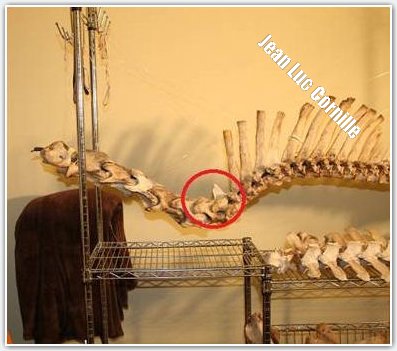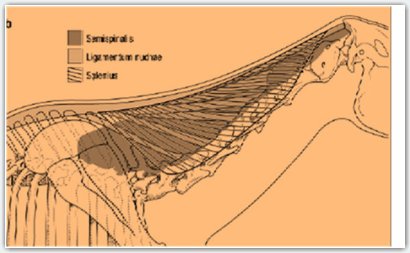Misconceptions part 2
Misconceptions about Long and Low
Part 2
Several metaphors are used emphasizing the thought that the horse neck reach out of the shoulder. The words “telescoping action are often used. One of the illiterate who reacted vehemently against our publication in face book, stated, “stretching out through the bit.” I love this one; it is typically the type of cocktail party theory which does not have any meaning but sound like a nice music.
Is it possible for the horse’s neck to reach out like a turtle? The response

is simple, no. Here is the picture of the cervico-thoracic junction. There are two powerful muscles named scalenus that stabilize the junction. Quite obviously the neck does not have any possibility of reaching out.
At the other end of the cervical vertebrae, the head can take a more horizontal position giving the optical illusion that the head extends prolonging the elongation of the upper neck muscles. There are over 20 pairs of muscles that control head movements. When the S shape of the cervical vertebrae take a more horizontal linkage and the head adopt a more horizontal position, it is not the upper neck muscles that became longer but instead, it is two different muscular system creating simultaneously a neck movement for the upper neck muscles and a head movements for the numerous muscles moving the head. The combination of these two movements is interpreted as an extension of the upper neck muscles. Once again, the response is in the architecture of the upper neck muscles.
For the splenius, the misconception is easy to understand since the muscle is not even inserted on the skull. The splenius is inserted on the nuchal crest.
Image by Karen Gillman

The semispinalis capitals is inserted on the nuchal crest of the skull but a closer look at the muscle architecture contradict any theory advocating stretching of the whole muscles. As explained and illustrated in IHTC4, the semispinalis capitis is a muscles built in compartments. Studies in neural compartmentalization have suggested that the cranial and caudal portion of the muscle act independently during normal head and neck movements.
The insertion of the semispinalis capitis on the dorsal crest of the skull suggest that the muscle would be involved in the extension of the head. However, it would involve only the upper compartment of the muscle situated above the central tendon and it would be a concentric contraction pulling the skull backward and therefore the nose forward.
All the expressions stretching through the bit, telescoping action, reaching out of the shoulders and many other are metaphors describing visual impressions but have no meaning whatsoever when it cone to the vertebral column mechanism. The problem is that as they are repeated over and over, these paraphrases became reality in the mind of the students. From these utopias, training and riding techniques are promoted. They are not even close form the way the horse physique effectively functions and their application, of course, cripple the horses.
Thomas Pain’s reflection is definitively the best conclusion for this discussion, “A long habit of not thinking a thing wrong, gives it a superficial appearance of being right.”
Jean Luc
Science Of Motion
Jean Luc Cornille
scienceofmotion.com


 twitter
twitter facebook
facebook google
google pinterest
pinterest linkedin
linkedin